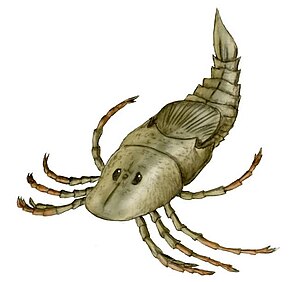Megarachne
| Megarachne | ||||||||||||
|---|---|---|---|---|---|---|---|---|---|---|---|---|

Megarachne servinei , reconstruction of life |
||||||||||||
| Temporal occurrence | ||||||||||||
| Upper carbon | ||||||||||||
| 300 million years | ||||||||||||
| Locations | ||||||||||||
| Systematics | ||||||||||||
|
||||||||||||
| Scientific name | ||||||||||||
| Megarachne | ||||||||||||
| Hünicken , 1980 | ||||||||||||
| Art | ||||||||||||
|
Megarachne ( gr. Μέγας Mégas "large" and ἀράχνη Arachne "spider") was considered the largest spider that has ever lived. Since the fossil has features that are not found in other species of spiders, the association with the spiders has been strongly doubted by many scientists. In the meantime it seems to be certain that Megarachne is not one of the spiders, but one of the now extinct Eurypterids , i.e. one of the sea or giant scorpions. Only the type species Megarachne servinei has been scientifically described .
Description and taxonomic reassessment

Megarachne servinei lived in the carbon and had a body length of 34 cm. Leg span estimates ranged from 50 cm to 70 cm.
The Megarachne does not resemble any current species of spider, which is why it - as it now turns out, wrongly - classified in its own family of spiders (Megarachnidae). The classification was based on features such as the shape of their shell , the design of their mouthparts , their circular abdomen (?) And the 15 mm large, circular eye that lies between the two other eyes in the middle of the head.
Only more extensive analyzes carried out by Paul Selden and his colleagues at the University of Manchester showed that megarachne can be assigned to the sea or giant scorpions (Eurypterids). In addition to the existing specimen from 1980, the researchers had a newer find available for their investigations, so that further important findings on taxonomy could be obtained.
Habitat and time
Megarachne servinei lived in the Upper Carboniferous 200 million years before the dinosaurs , which was decisive for its size. In the Carboniferous region, huge rainforests dominated the earth ( see : Coal ), which resulted in an enormous oxygen content in the atmosphere . Since arachnids and insects need a lot of oxygen to grow, this was the perfect time.
discovery
In 1980 Prof. Dr. Hünicken found the first fossil of a megarachne in the upper carbon layer in the Argentine province of San Luis . This was the first Megarachne servinei find . In the meantime, another fossilized specimen has appeared, which was also discovered in Argentina.
The "greatest spider of all time"
When Megarachne was eliminated , the Theraphosa blondi tarantula , with a leg span of just under 30 centimeters, was the largest spider in the world until 2001.
However, the Laotian real spider Heteropoda maxima is larger than T. blondi . H. maxima , found in Southeast Asia in 1939 and described in 2001, has a leg span of 35 centimeters.
literature
- Hünicken, MA (1980). A giant fossil spider ( Megarachne servinei ) from Bajo de Véliz, Upper Carboniferous, Argentina. Boletin de la Academia Nacional de Ciencias, Córdoba, Argentina 53 : 317-341.
- Selden, PA, Corronca, JA & Hünicken, MA (2005). The true identity of the supposed giant fossil spider Megarachne . Biology Letters 1 : 44-48. doi : 10.1098 / rsbl.2004.0272
Web links
- Spanish and French text about Megarachne ( Memento of December 2, 2007 in the Internet Archive )
- The largest 'spider' ever? ( Memento of July 23, 2008 in the Internet Archive ) Australian Museum
- www.wissenschaft.de: The record spider that was a scorpion - The "greatest spider of all time" actually belongs to the sea or giant scorpions
